-
Mob.:
+86 135 9088 4785
+86 135 9088 4785
At present, the diffuser plate is an important optical diffusion part inside the TV set, which can distribute the light emitted by the LED in the TV set uniformly. It can make the light of LED in the TV set evenly distributed. In this paper, transmittance (T.T.), fog degrees (HAZE) and brightness (Lv) three aspects were studied, the main and auxiliary materials including GPPS, organic silicon light diffusion agent, inorganic optical diffusion agent and anti-aging agent were analyzed, and several kinds of organic and inorganic optical diffusion agents were compared and analyzed. The results showed that when the organic silicon light diffusion agent dosage was 0.6%~0.8%, the inorganic optical diffusion agent was 0.15%, the transmittance reached (43±3) %, the fog degree was up to 99.4%.
The usage of LED optical diffusion plates is increasing rapidly, the whole spherical liquid crystal shipment reached more than 210 million sets in 2017, and the demand for diffusion plates is huge, so it is of great significance to study the specific diffusion plate suitable for customers. The two main indexes to evaluate the optical properties of optical diffusion plates are light transmittance and haze. The light diffusion plate is mainly made of GPPS, MS, PMMA, PC, etc., adding some organic light diffuser or/and inorganic light diffuser and some other toughening agents, anti-aging auxiliaries, etc., which are fully mixed and extruded through an extruder, and then extruded into a certain thickness plate through a specific die, and then cut into the required size of the backlight module in the TV set by CNC. we studied the correspondence and added PMMA (cross-linking type) microsphere light diffuser to PC. The effects of light diffusion mechanism and particle size of light diffuser on the light transmittance (T.T.) and haze (HAZE) of PC light diffuser were analyzed. The results show that when the particle size of the light diffuser is 20 μ m, the light transmittance of the PC light diffusion plate is higher, and when the particle size of the light diffuser is 1. 8 μ m, the particle size of the light diffuser increases, the light transmittance increases and the haze decreases.
PET Reflective Film JK-RF225
In addition, light diffusion panels are also used in lighting, but most of them require high transmittance, with a haze of 80% to 90%. However, in the TV industry, the transmittance of general demand is not higher than 60%, and the transmittance of customers is about 43%. There are other customer demand transmittance 55% and so on. Through the analysis of a large number of experimental data, it is concluded that when the only organic light diffuser is used to obtain low transmittance, on the one hand, the cost of organic light diffuser is quite high, on the other hand, the amount of organic light diffuser is relatively large, and the contribution rate to transmittance is relatively low when the dosage is higher than 1%. It is not economical to use organic light diffuser only to produce light diffusion plates with transmittance of less than 60%. Organic light diffuser. It includes silicone resin light diffuser (refractive index 1.43), phenylethene type light diffuser (refractive index 1.55), pressure force type light diffuser (refractive index 1.5) and so on.
Silicone light diffusion agent is organosilicon polymer. Silicone polymer is a polymer with silicon element in molecular structure and organic functional groups connected to silicon atoms. Polysilsesquioxane microspheres were prepared from alkoxysilane (such as methyl trimethoxysilane, phenyl trimethoxysilane, etc.) by hydrolysis, condensation and cross-linking reaction. the particle size distribution is between 1 μ m and 8 μ m, and the average particle size is 2 μ m [5]. Among them, silicone light diffusion agent has the best heat resistance and high-temperature resistance, high diffusion efficiency, good compatibility with the matrix resin, low specific gravity, good dispersion, better balance of light transmittance and evenness, and organic silicone resin light diffusion agent is the first choice. the inorganic optical diffuser includes titanium dioxide, silicon oxide, calcium carbonate, aluminum hydroxide, zinc oxide, glass beads, etc. [6]. Among them, the refractive index of titanium dioxide is the largest, the refractive index of rutile titanium dioxide is about 2.73, that of anatase titanium dioxide is about 2.55; the refractive index of zinc sulfide is 2.37, the refractive index of zinc barium white is 1.84, the refractive index of zinc oxide is 2.02, and the refractive index of silicon dioxide is about 1.45. Only from the refractive index side, rutile titanium dioxide can more effectively reduce the transmittance and play a high shielding role. Another point is good anti-oxidation and good weather resistance. Therefore, rutile titanium dioxide is the preferred inorganic light diffuser in the diffusion plate with low transmittance.
1) Twin Screw Extruder.
2) injection molding machine.
3) Color Analyzer CA210.
4) haze tester NDH7000.
5) LED-TV backlight module.
6) complete sets of equipment for sheet metal forming.
7) CNC cutting machine.
8) off-site emission scanning electron microscope (SEM).
Optical grade GPPS; silicone light diffuser: WD-101 with 1 μ m particle size, WD-102; inorganic light diffuser with 2 μ m particle size, rutile titanium dioxide (R103 and R930) with the particle size of about 230nm, light stabilizer: LS770; ultraviolet absorber: UV329; antioxidant: 215, white oil.
It can be seen from figure 1 that the transmittance (T.T.) of 1 μ m WD-101, 2 μ m WD-102, WD-101 and WD-102 increases with the increase of dosage. It will decrease accordingly, but when the decrease is less than 0.5%, the change of transmittance is very obvious, and there is a linear decrease between 0.5% and 1.0%. When the dosage is more than 1.0%, and then increase the dosage, the effect on the transmittance will be reduced, therefore, the dosage of silicone diffuser generally does not exceed 1%. Through the experiment, it is known that when the dosage of DF10A0 is 0.5%, the haze (HAZE) has reached 99%. The effect of the particle size of 1 μ m on the transmittance is greater than that of 2 μm because the smaller the particle size is with the same amount of diffuser.
The more the number of effective spherical particles is, the greater the probability of scattering is, and the transmitted light will be reduced accordingly, so the transmittance of the diffusion plate will be lower with the smaller the particle size. It is affected not only by particle size, but also by sphericity, particle surface regularity, concentration, particle size distribution, and so on.
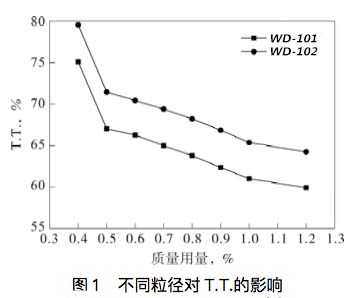
Fig.1 The influence of different particle size on transmittance
Through scanning electron microscope figure 2, it can be seen that silicone diffusion agent is a small round microsphere. Microscopically, the material is a transparent sphere, so it can provide superior light transmittance and has a very low refractive index compared with acrylic acid and styrene, so it has a large difference compared with the refractive index of the substrate GPPS, which will give light transmittance to the light diffusion agent at the same time. It also gives the material a high haze. When the light line passes through the surface of the microsphere, a part of the light is scattered by the difference in refractive index between the diffuser and the main material, and part of the light passes through the microsphere, and the incident light is finally decomposed into light lines in numerous directions. achieve the comfortable effect of light transmission and opacity.
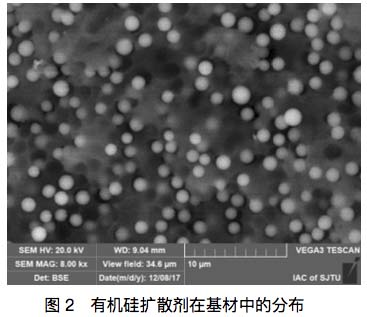
Fig.2 The distribution of organ silicon diffuser in the base material
It can be seen from figure 3 that rutile titanium dioxide has the greatest influence on transmittance. The main reason was that the refractive index of rutile titanium dioxide is the largest. The particle size of titanium dioxide commonly used in plastics is usually 0.15-0.3 μ m. This range can achieve the best whiteness, and the blue background phase can be obtained, which can mask the yellow phase. Rutile titanium dioxide has strong anti-ultraviolet ability and can effectively scatter ultraviolet rays in the UVA area. Therefore, when the dosage of titanium dioxide is 0.15% and the thickness is 1.2 mm, the transmittance is about 43%, which mainly result is light reflection. However, when only titanium dioxide is used as diffuser, the uniformity of the diffusion plate is relatively poor, which can be attributed to the small amount of titanium dioxide and the high density (4.1 g/cm3), it makes the effective content of the substrate low. Through the experiment, the light near the lamp bead passes through more, but the light can be clearly seen; while the light far away from the lamp bead is less, and the light naturally passes through is also relatively less, resulting in a low Lv. In order to improve this phenomenon, normally it is used in combination with silicone diffuser.
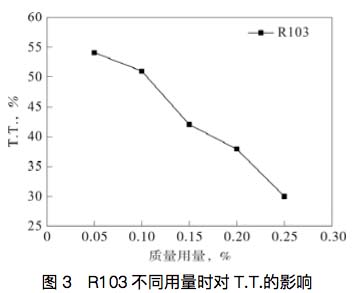
Fig.3 The effect of different content of R103 on T.T.
The trend of figure 4 is that the mass dosage of WD-101 is 0.6%. Through the experiment with WD-101 alone, it is known that when the dosage of WD-101 reaches 0.6%, a good haze (about 99.4%) can be obtained. Through the comparative analysis of two kinds of rutile titanium dioxide R930 and R103 with a particle size of 0.23 μ m and 0.25 μ m, it is found that there are some differences in TIO2 of the same type and particle size, especially when using < 0.1% or > 0.2%. This is mainly because R103 is produced by chlorination process, the treatment method is alumina and organic matter treatment, R930 is sulfuric acid process production, and the treatment mode is alumina and SIO2 treatment. Therefore, it is also very important to choose a suitable titanium dioxide.
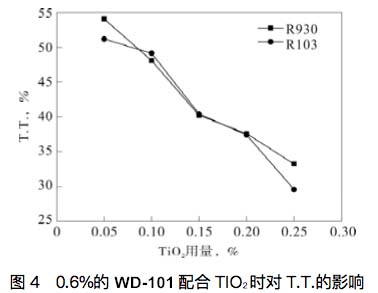
Fig.4 The effect of 0.6% WD-101 and different content of TIO2 on T.T.
Through scanning electron microscope figure 5, it can be seen that organic silicone light diffuser can effectively fill the gap of titanium dioxide. The difference of refractive index between silicone diffuser and substrate resin GPPS can fully scatter the light source, and can scatter the light reflected by titanium dioxide again, so that the light can be dispersed more evenly. By testing the brightness of 9 points, it is found that the light reflected by titanium dioxide can be scattered again. The uniformity of the diffusion plate is obviously better than that of the inorganic diffuser alone, and the bad phenomenon of uniformity when using only titanium dioxide is well improved.
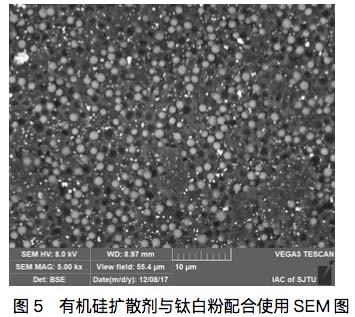
Fig.5 The SEM of the diffuser plate with organ silicon diffusion agent and titanium dioxide
Figure 6 shows that the content of WD-101 is 0.6%. Through the comparative analysis of the three thicknesses of 1.0 and 1.2 mm with different titanium dioxide content, it can be seen from figure 5 that the thicker the diffusion plate is, the greater the effect on the transmittance is, because the thicker the diffusion plate is, the greater the diffusion dose of the same size diffusion plate will be. When the light is out of date, there will be more opportunities for scattering and reflection, so that the better the light uniformity of the diffusion plate is, the lower the transmittance of the diffusion plate will be.
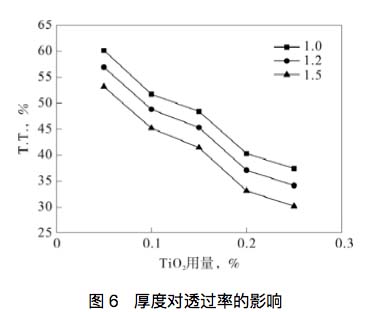
Fig.6 The influence of thickness on transmittanc
As compared to different particle sizes and different dosage of silicone diffuser. the analysis of the experimental data is as follows: the effect of particle diameter of 1 μ m on transmittance is greater than that of 2 μ m, because the same amount of silicone diffuser, the smaller the particle size is, the more effective spherical particles are contained, and the greater the probability of scattering is, the less transmitted light will be. So the transmittance of the diffusion plate will be lower when the particle size is smaller. When the dosage is less than 1.0%, the effect of increasing the dosage on the transmittance is more obvious, and when the dosage is more than 1.0%, the effect on the transmittance is reduced by increasing the dosage. When silicone diffuser is used alone, it takes more amount to achieve a transmittance of less than 50%, and there is no cost advantage.
Anaylysiing the type selection and dosage of inorganic diffuser titanium dioxide . It can be seen that when inorganic diffuser is used alone, the light transmission uniformity of diffusion plate is not good. Through the analysis, it is known that the effect of rutile titanium dioxide is the best. The production effect of rutile titanium dioxide by chlorination method is better than that by sulfuric acid method, and the modification of titanium dioxide is also one of the key points in type selection. It is particularly important to choose a suitable inorganic diffuser.
Finally, compared between the score of the combination of organic and inorganic diffuser.
Analysis, through the analysis, we can know that the final use of organosilicon diffuser and inorganic diffuser rutile titanium dioxide, according to different thickness, using different formula, achieved the ideal effect. The results show that when the dosage of organic silicon light diffuser is 0.6%-0.8%, and the amount of rutile titanium dioxide is 0.15%, the thickness is 1.2 mm, the transmittance can reach (43 ±3)%, and the haze can reach 99.4%.
So, do you know how to choose a suitable light diffusion agent for the diffuser plate/diffuser sheet now? should you any questions or help welcome to leave a message in comments or send my email: Sales@jk-optics.com.

Copyright ©Kunxin New Material Technology Co., Ltd. All Rights Reserved | Sitemap | Technical Support: 